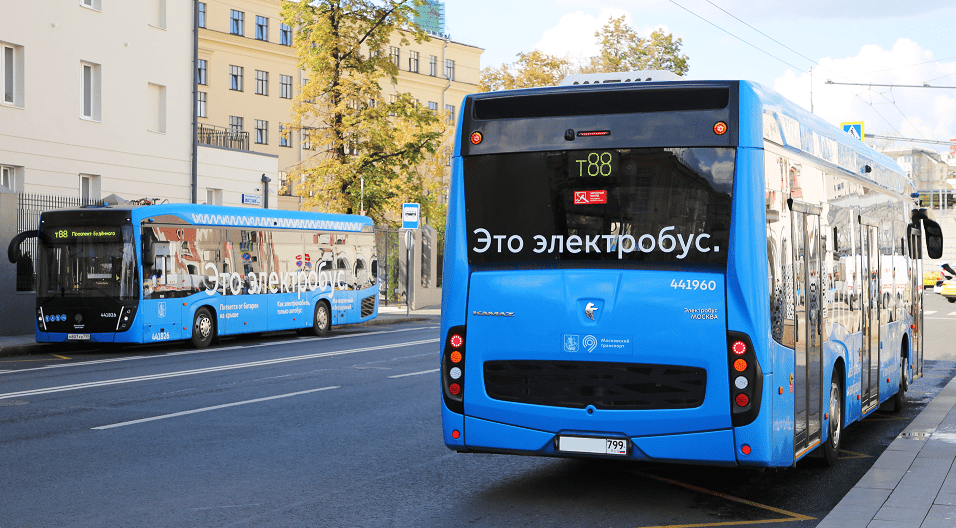Kamaz-6282 Electrobus

Three Kamaz-6282 near Europe square (Moscow)
KamAZ-6282 is a Russian low-floor electric bus jointly developed by NefAZ and KamAZ.
Equipped with three route indicators in the front, starboard and rear parts of the electric bus. Additionally (by order of Moscow), a route indicator-monitor is installed that displays the remaining stops along the way. The electric bus is two-axle, the rear wheels are driven. The front suspension is independent, pneumatic with an electronic control system and body tilt function. The rear suspension is dependent, pneumatic. The braking system is mechanical, disc, auxiliary braking is coupled with an electric motor and is equipped with an energy recovery system in the brake drum.

Kamaz-6282-121 (left) and Kamaz-6282 (right) near Kazanskiy Railway terminal (Moscow)
The electric bus has three doors for boarding and disembarking passengers. The bus has 33 seats. The seats are anti-vandal, plastic. There is a place for disabled people in the storage area; a folding ramp is installed on the middle door. The glazing of the electric bus is tinted, the windshield is panoramic, glued in. The driver’s seat is adjustable, pneumatic.

KamAZ-6282 on the Yauza embankment
The electric bus is equipped with lithium titanate batteries. Features of this type of battery are a very large number of charge-discharge cycles (the manufacturer claims 20,000 cycles), the ability to operate at low temperatures (down to −40 °C), and the possibility of ultra-fast charging (up to 6 minutes). The battery capacity is 80 kWh, the range on one charge is up to 70 km. At the end stations there are charging stations where electric buses are charged (charging to 80% takes 20 minutes).

Kamaz-6282 near Mayakovskaya metro station (Moscow)
Modifications
KamAZ-6282-121
The modification is equipped with lithium titanate (LTO) batteries.
KamAZ-6282-123
The modification is equipped with lithium-nickel-manganese-cobalt (NMC) batteries.
KamAZ-62825
The model is a trolleybus with increased autonomous travel.
KamAZ-6290
The low-floor model is built on the basis of the KamAZ-6282 electric bus. The electric bus with hydrogen fuel cells is equipped with six cylinders for storing compressed hydrogen. In this case, the cylinders are installed on the roof. The new bus is driven by an electric portal bridge from ZF. The power of the hydrogen power plant reaches 45 kW. The maximum speed of the vehicle is 80 km/h. In addition, the KamAZ-6290 is equipped with a pneumatic braking system with EBS, ABS, ASR, EPB, a hill hold function, a motion blocking function when the doors are open, and a brake pad wear monitoring sensor. Braking is also provided by a traction electric motor with a recuperation system. The advantages of a hydrogen electric bus are environmental friendliness, the absence of a diesel heater and a power reserve of 250 km.
KamAZ-6292
The electric bus has a particularly large capacity and is built on the basis of the KamAZ-6299 bus.

Kamaz-6282 near Kiyevskiy railway terminal (Moscow)
Development: Neftekamsk (Republic of Bashkortostan, Russia)
Assembly: Сокольнический вагоноремонтно-строительный завод (Moscow, Russia)
Years of production: 2018—
Production: more than 900 items
Length: 12,400 mm
Width: 2,540 mm
Height: 3,260 mm
Capacity: 85 passengers (33 seats)
Engine: electric
Power: 2× 170 HP
Max speed: 70 km/h
Fuel consumption: 0 l/100 km
Range: 285 km
Recharging time: 8-20 min
Weight: 12,120 kg










